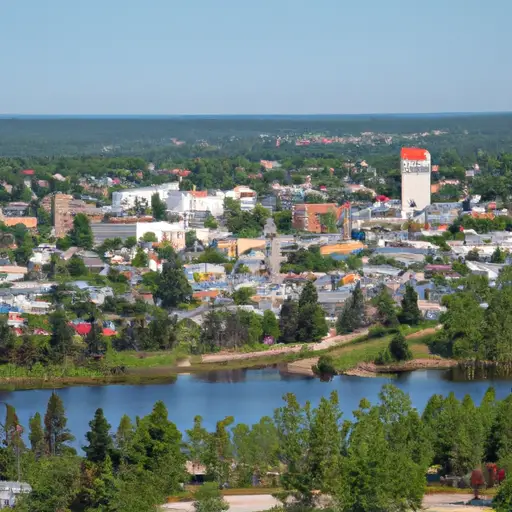Timmins : Interesting Facts, Famous Things & Information

- By
- Aparna Patel
- |
- 15 Jul, 2023
- |

Welcome to Timmins, a city founded in 1906 and located in Ontario, Canada! In this blog post, we will take a look at some of the most interesting facts, famous things, and other information about this vibrant city. With a population of over 41,000, Timmins is a major hub for commerce and entertainment. Learn the city’s history, see what sights and attractions it offers, and more in this comprehensive overview! Come along and explore what Timmins has to offer!
Table of Contents
History & Information About Timmins City
Timmins, Ontario, is a city in Northern Ontario, Canada. It is located in the district of Timiskaming, approximately 435km north of Toronto, and is the largest city in the region.
Timmins was founded in 1912, when two prospectors made a large gold discovery on Porcupine Creek. The miners, Noah Timmins and Alex Gillies, eventually founded a gold mining company in 1913, and the town of Timmins was born. The town grew rapidly over the years as new mines opened and businesses were established.
Today, Timmins is a major service and industrial centre for the area. It is the home of Canada’s largest gold mine, the Hollinger Mine, and other mines for gold, silver, copper, nickel and diamonds. The city is also home to a major research centre in mining technology called the Lakefield Research Institute, as well as to a number of manufacturing facilities that use local resources in the production of items such as glass bottles, paper products, boilers, industrial valves and mining equipment.
The city is considered to be one of the “song bird capital of Canada”, and a wide variety of birds can be seen in the area. Timmins also boasts a vibrant arts and culture scene, and is home to the Abitibi-Temiskaming Symphony Orchestra, as well as several art galleries and performing arts venues.
The city is also home to a large number of recreational activities, including downhill and cross country skiing, golf, hockey, curling, fishing and hunting. Timmins is served by a number of transportation networks, including Highway 101, a major north-south route that links the city to other communities throughout the region; and the Timmins airport which provides air connectivity to other destinations in Canada.
Interesting Facts About Timmins City
1. The city of Timmins is located in the centre of one of the planet’s largest gold and base metal producing regions.
2. The first goldrush to the area happened in 1909, when gold was found in a nearby area.
3. Timmins has its own major professional hockey team, the Timmins Rock, who plays in the Northern Ontario Junior Hockey League (NOJHL).
4. Timmins is home to Mountjoy Historical Provincial Park, which houses a preserved underground mine and the Timmins museum.
5. Timmins is the birthplace of Shania Twain, one of the best selling female country singers of all time.
6. The city has been called the “City with a heart of gold” due to its strong connection with the mining industry.
7. Timmins has a rich Franco-Ontarian culture, with roughly 34% of the population identifying as francophone, making it the most francophone city in Northeastern Ontario.
8. The area around Timmins is home to numerous First Nations Peoples, including the Cree, Algonquin, Metis, Ojibwa and Oji-Cree.
9. The city is also known to be difficult to spell, due to its combination of multiple letters and sounds which don’t exist in the English language.
10. Timmins has a rich mining history, having been the home of numerous mining companies including Kirkland Lake Gold, Quadra FNX Mining, and, Xstrata.
What is Timmins known & Famous for
Timmins is known as the “City with a Heart of Gold” and is famous for its natural resources, its vibrant arts and culture scene, and its status as a gateway to the Northern Ontario region. The city is known for its large gold and diamond deposits, especially in the nearby Porcupine and Kirkland Lake regions. Timmins is also known for its outdoor activities, such as snowmobiling, fishing, camping, and sightseeing. The city is known for its many protected parks and recreation areas, such as Mount McIntyre Ski Hill and Porcupine Mountains Provincial Park.
- Hamilton : Interesting Facts, Famous Things & Information
- Barrie : Interesting Facts, Famous Things & Information
- Brampton : Interesting Facts, Famous Things & Information
What Is It Like To Visit In Timmins City?
Timmins is a great city to visit with a lot of unique experiences to offer. It is known for its role in the gold rush history of the Canadian north and has a lot of museums and cultural attractions for visitors to explore. There are outdoor activities to enjoy like camping, fishing, and golfing. There are also plenty of restaurants and events to explore that showcase the culture of the area. The scenery is stunning, with vibrant fall colors and beautiful, snow-dusted landscapes in winter.
Search Posts
Latest posts
Popular posts
-
5 Mar, 2024
Why prohibit engine braking?
-
5 Mar, 2024
How to avoid drinking vodka?